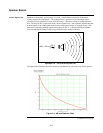
2-2
Audio engineers use “Decibels” (dB) to express ratios between levels, such as power, Volts,
Amps, and Sound Pressure Levels (SPL). The decibel is not an absolute measure like Volts and
Amps, rather it is used to make comparisons between two numbers. The decibel is defined as the
logarithm of two power levels, shown below in the equation as P
1
and P
0
:
⎟
⎠
⎞
⎜
⎝
⎛
=
0
1
P
P
log10 Decibel
Equation 2-1. The Decibel
P
0
is the reference power and P
1
is the power level used for comparison. The logarithm is used in
the decibel in order to make comparisons of power over a very wide range. This is very useful in
audio applications as the ear responds logarithmically to changes in SPL.
You can also use the decibel for voltage comparisons. From Ohm’s Law we know that:
RIV
×
=
Equation 2-2. Ohm’s Law
The electrical power equation:
RIP
R
V
PIVP
2
2
×==×=
Equation 2-3. Power Relationships
Use the following equation to determine the decibel difference between two voltage measurements
powering the same load resistance:
()
()
⎟
⎟
⎠
⎞
⎜
⎜
⎝
⎛
=
⎥
⎥
⎥
⎥
⎦
⎤
⎢
⎢
⎢
⎢
⎣
⎡
=
0
1
2
0
2
1
V
V
log20dB:tosimplifiedbecanwhich
R
V
R
V
log10dB
Equation 2-4. dB and Voltages
The decibel is often used to make comparisons between two different numbers, neither of which is
at an absolute reference level. For instance, if we take two voltage measurements along the length
of a speaker circuit, the power lost to the wiring can be calculated directly. If the voltage at the
amplifier driving a speaker circuit is 25 V (V
0
) and the voltage at the last speaker on the circuit is
15 V (V
1
) the power loss due to the wiring is 4.4 dB.
Continued on next page
Basic Audio Math
Ohm’s Law
and the Decibel
Where:
• V = Volts
• I = Amps
• R = Resistance


















